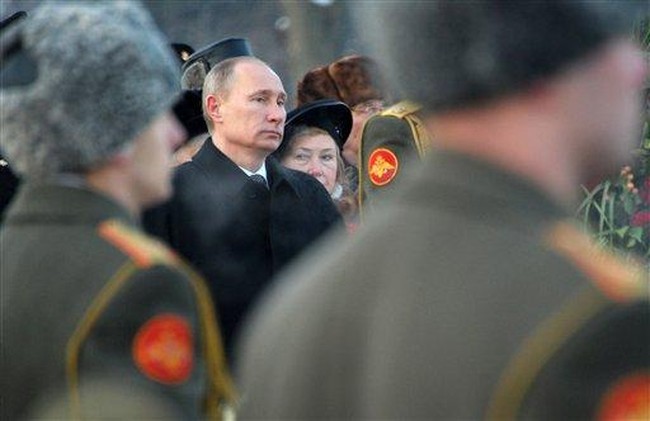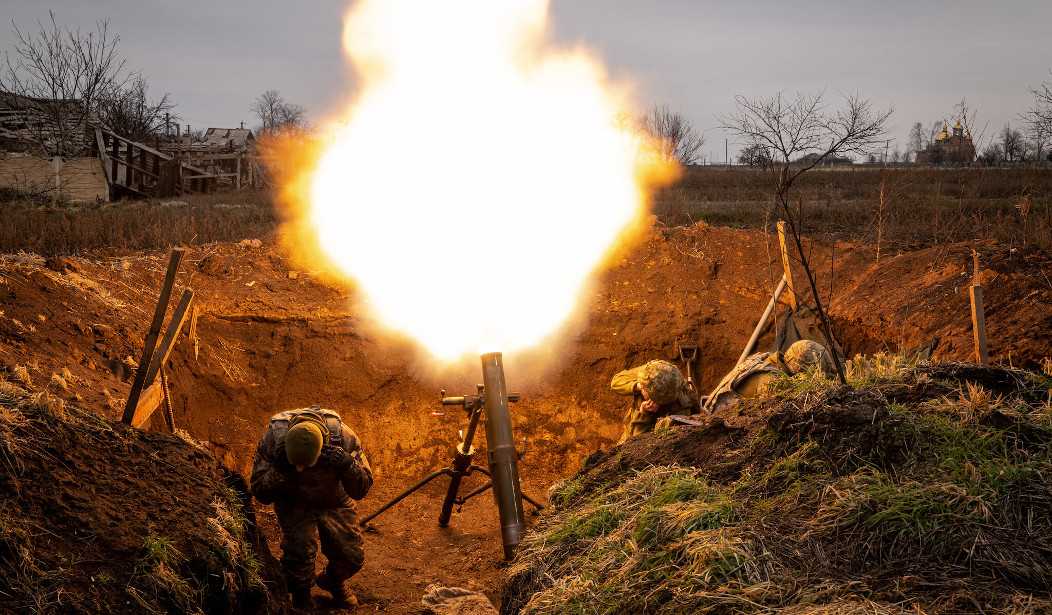As you may have noticed, our media would like to tell us what to think. In reality, they are only good at telling us what to think about. And some of them haven’t even figured that out yet.
They are expert at telling us to think about the movement of numerous grains of sand on the beach. One inch here, a half-inch there. Wow, three inches over there.
But they are absolutely awful at noticing that the entire beach is eroding.
Thus, Washington media focuses on telling little-picture stories about House arguments, committee votes, stupid statements, and photo stunts. They are the easiest — and cheapest — to tell.
What we rarely get are important — and often ominous — overviews about larger trends affecting the country, especially concerning national security. We are currently slipping heedlessly into deep water on one of those: military aid to enable Ukraine to continue fighting against its invading neighbor.
There is no moral argument in our democracy against helping Ukraine. None.
The United States would not exist, and we would be living an entirely different history had France not helped George Washington’s hard-pressed Revolutionary Army to maintain our new independence from Britain in 1778.
That wasn't simply charity. France had its own strategic self-interest in doing that. Guess what? So do we in Ukraine.
While we and our European allies, who are donating much more than we are, send billions in military aid to help Ukrainians keep their independence from Vladimir Putin’s “special operation,” we are simultaneously enabling the devastation of Russia’s military capabilities to continue Putin’s expansionist aims into other European countries.
And all without shedding one single drop of American blood.
According to U.S. intelligence, Russia has lost — killed or wounded — nearly 90 percent of its prewar military of 360,000, plus almost two-thirds of its tank forces that were 3,500. Also, about 15 percent of its 900 prewar military aircraft, plus an unknown amount of extra debilitating wear on the remainder.
In addition to thousands of prison inmates, Moscow’s military has recruited another 300,000 this year, though their training is minimal.
Ukraine keeps its losses secret, but they were estimated last summer at around 70,000 killed. Medical care at the front is rudimentary for Ukrainians and often delayed.
Russian care there is virtually nonexistent. Ukrainian drone video has shown wounded Russians killing themselves rather than suffer unattended in muddy trenches.
Adolf Hitler and Saddam Hussein are not the only models for dictators who seize neighbor nations until others summon the will to stop them with force.
Unless defeated now, Putin’s next conquests would be the Baltic states. He’s already making the argument that Russian peoples there need protection, a favorite excuse of Hitler about Germans outside Germany.
Here’s the catch: Putin moving there would instantly involve the active military of all NATO allies, including the U.S. Better to stop the aggressor now by donating metal equipment, gear, and explosives than the lives of U.S. and NATO service members.
Donald Trump rightly boasted about avoiding new military conflicts during his presidency. So far, for all his clumsiness elsewhere, Joe Biden has followed that example.

I have praised that career politician here for his stalwart commitment to Ukraine for as long as it takes. Polls show that’s one policy area voters have supported him, though that support is weakening. The real test comes next year if Biden really is Democrats’ nominee and that voter/Biden support wanes further.
Putin is counting on voter impatience within Western democracies, something that need never concern him, even in next year’s Russian “elections.”
Putin is prepared to spend the lives of as many Russian males as it takes to outlast Western countries where leaders must face voters in honest elections. Oh, look, we have one in just 324 days.
Rumbles of impatience over the lack of victory or dramatic progress have already been heard in Europe and Congress from folks who are watching safely from afar. And, sadly, history in Vietnam and Afghanistan shows the U.S. willing to quit if not winning quickly.
Putin has reason for hope. Hungary’s Viktor Orban is now blocking $55 billion European Union aid to Ukraine, which helps Putin.
Polls show the percentage of Americans who think the U.S. is doing too much to help Ukraine is still a minority but growing in recent months.
And a few rowdy Republicans in the GOP’s tiny House majority are using their leverage to bargain for southern border enforcement, which Biden stupidly linked with Ukraine aid.
Biden has spent his public time in recent months vainly claiming the great successes of Bidenomics.
So, mentally and politically, he is in no shape to argue effectively the obvious American self-interest in helping Ukraine with piecemeal arms packages that exaggerate the scale of financial help when he fails to refill the Strategic Oil Reserve and does nothing about the porous border with Mexico inflicting billions in new costs on cities and states.
Nor has Biden deigned to explain his willful abandonment of Trump’s border control policies, and complicit media has not pressed him on why.
As a result, nearly nine million illegal aliens, including Europeans and Chinese, have infiltrated the country with no meaningful tracking, putting extreme financial pressures on local social, legal, and educational institutions. And who knows the intentions of some?
During the Obama years, Homeland Security complained it was overwhelmed by 1,000 illegal immigrants attempting to cross the border in a week. Recently, some 10,000 new illegals cross over daily with no Biden reaction.
One argument against sending aid to Ukraine is that we need it to protect our own border, which Joe Biden has failed to do.
Two things on that: What we are sending to Ukraine is overwhelmingly 155-millimeter artillery rounds, tanks, armored personnel carriers, F-16s, anti-tank missiles, and millions of rounds of ammo.
None of that would be practically useful, even if Joe Biden did allow border enforcement.
There is so much of that lethal materiel here in long-term storage because it was prepared for the anticipated conflict with Russia on the plains of Europe.
After the Soviet Union’s 1991 fall, much of that arms industry and its many subcontractors moved on to other projects or even shut down, both here and in Europe.
So, strategists charged with planning protective preparations for future conflicts are pleased to have those defense resources and skills coming back online.

The most likely future conflict is now a maritime one with China involving naval and air forces.
While still lethal, of course, such equipment makes ideal candidates for transfer to Ukraine, where it could defeat Russia now and possibly prevent its future aggressions.
Second – and this surprised me — about 90 percent of the $68 billion in U.S. military aid during this war has not actually gone to Ukraine. It stays right here at home to pay for building armaments ordered from U.S. companies employing U.S. workers.
Marc Thiessen and colleagues at the American Enterprise Institute compiled a major study of where the Ukraine spending is going.
They found 117 production lines in 71 cities and 31 states are the ones actually receiving billions in so-called “Ukraine aid.”
As one example, they cite Stinger anti-aircraft missiles. None have been made in 18 years. But some $624 million is now pouring into Arizona to replace stockpiles sent to Ukraine, which will now be available for future U.S. use.
Another example of reinvigorating the “dangerously atrophied defense industrial base” is production of important defense materiel like 155-millimeter artillery shells.
Before the Russian invasion 22 months ago, the U.S. was making less than 15,000 a month, about two days’ supply for Ukraine’s artillery. A new Pentagon contract uses Ukraine aid money to boost production by five-fold, also restoring U.S. stockpiles of that essential combat ammunition.
And, of course, there’s the economic multiplier effect to subcontractors making computer chips and other parts and local businesses serving workers and their families with groceries, cars, clothing and so forth.
And yet, Thiessen’s study found, counterintuitively:
Thirty-one senators and House members whose states or districts benefit from military funding for Ukraine have voted to oppose or restrict that aid.
These outspoken opponents include J.D. Vance and Jim Jordan of Ohio, home to the nation’s only manufacturer of Abrams tanks.
Other outspoken Ukraine aid opponents include Missouri’s Josh Hawley, Alabama’s Tommy Tuberville, Indiana’s Mike Braun, and Florida’s Matt Gaetz, all representing states or districts receiving substantial defense spending for Ukraine’s fight.
Ukraine’s President Volodymyr Zelensky visited Biden last week to plead for more aid quickly. The response was underwhelming and surely encouraging for Putin.
Without sufficient and timely ongoing aid from the U.S. and Europe, it seems inevitable that Russia’s Putin will succeed in acquiring the rest of Ukraine that he started taking in 2014, when the West did not nothing effective in response. After not doing anything effective when he took over parts of Georgia in 2008.
Then we can add Ukrainians to the growing list of people in countries like Vietnam and Afghanistan who trusted the U.S. when we said we'd help as long as it took, but got abandoned because we simply lacked the will and effective skills to stick with them.
Related Post:
Putin's Annual Public Question Time Had Some Tough Questions













